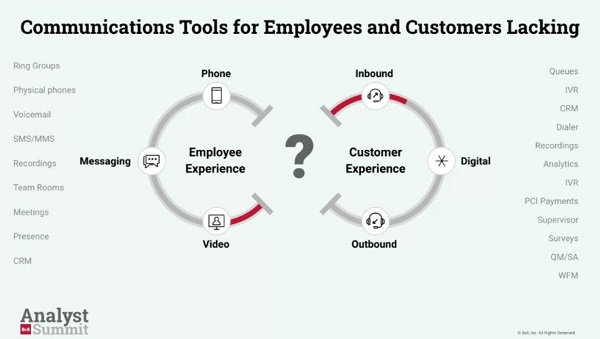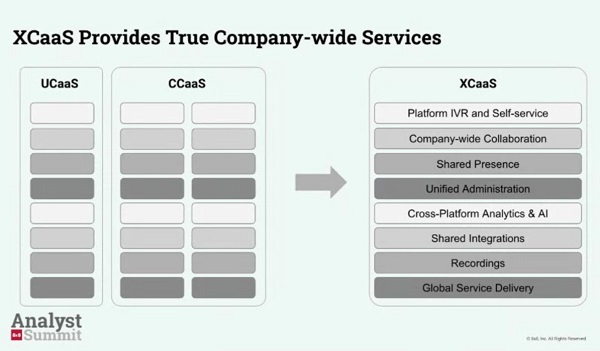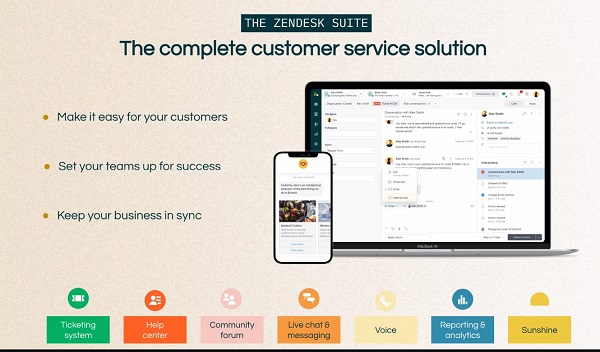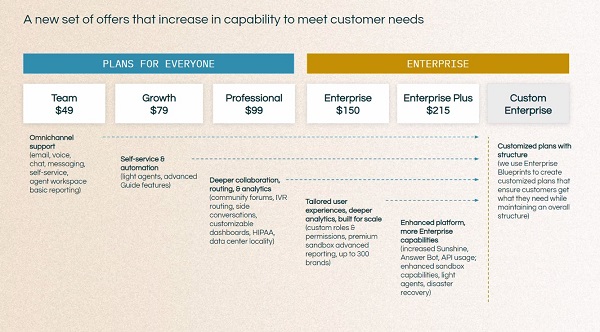Last week, I attended four virtual analyst events hosted by Zoom, 8x8, Zendesk, and Verint, and noticed these overriding themes:
- COVID-19 changed everything, and organizations must revisit the way they look at both the customer and employee experience.
- Hybrid work will be the way forward, which means organizations must adapt and find ways to help their employees in this new environment. The old way of working, whether for enterprise knowledge workers or contact center agents, is changing, necessitating new tools and approaches.
- Openness, as well as the expanding role of third-party apps and developer tools to help create, embed, and integrate these apps, will result in enhanced employee and customer experiences.
- The expanding integration of previously separate applications and functions, most notably:
- Contact center + CRM
- Unified communications (UC) + contact center
- Contact center + workforce engagement management/workforce optimization.
Below is a recap of these events, announcements made, and talking points that resonated most.
Zoom Goes from Verb to Platform
The hybrid workplace employee experience was highlighted at Zoom’s Perspectives 2021 analyst summit, with video and meetings play a key role in helping distributed teams and workers communicate. As Ryan Azus, Chief Revenue Officer, Zoom, noted, “Going forward we see the world going hybrid. We’ll return to our offices but not in the same way as before, and we won’t be in the office as frequently as before.” Jeff Smith, Group Product Manager, and Head of Zoom Rooms noted that hybrid will be the normal working style because individuals will choose where they want to work based on where they’re most effective (in-office vs. remote). While the office will be a welcoming and collaborative space for in-person interactions, not everyone can be in the same place at the same time. Tools like whiteboarding, Zoom for Home Appliances, Zoom Smart Gallery, etc., will help “transport the people into an equitable office,” Smith said. The diagram below shows how Zoom is enabling the hybrid workplace.
While many businesses will return to hosting and attending live events in the coming months, virtual events aren’t going away. Zoom
announced Zoom Events, which will let customers host a variety of event types, engage with participants, monetize events, and create event channels. Several vendors have set their sights on virtual event platforms in the past year. Cisco recently
announced its acquisition of Socio Labs, an event technology platform for in-person, virtual, or hybrid events.
Zoom Events, an all-in-one platform combines Zoom Meetings, chat, and video webinars in one solution for event organizers, with the ability to produce ticketed, live events for internal or external audiences of any size. As much as we all want to gather at live events in person, the reality is that virtual events are here to stay, and Zoom is in the right position to leverage its video and meeting capabilities for this new platform.
Another focal point at the analyst summit was Zoom’s transition from a killer app to a more serious platform play. Zoom made it clear that beyond being a verb and a household name, the company has focused on innovation as a platform. Eric Yuan, CEO, Zoom, laid out the company’s platform vision, emphasizing that "we want to be the full UC stack, pivoting from providing a video application to a full UC platform.”
Yuan explained that Zoom is transforming its business from video communications to a platform play, with Zoom Apps (bringing apps from Zoom partners directly into the Zoom experience), third-party integrations, and Zoom SDKs. These will let application developers embed video in social, gaming, retail, and business applications to enhance the user experience.
Zoom Phone is another big part of the platform play. “We're seeing a push from customers who have embraced Zoom from a video perspective and want to consolidate their UC with a single vendor delivering it,” Graham Geddes, Head of Zoom Phone & Rooms, Sales, and Go-To-Market, told analysts. With Zoom Phone and the Zoom platform, the company can deliver one app for meetings, chat, phone, rooms, webinars, etc., with the same user interface.
Zoom Phone’s growth has been extremely impressive. For example, the number of Zoom Phone customers with more than 10 employees grew 269% since 2020, from 2,900 to 10,700. With more than 400 features and enhancements, Zoom Phone is closing the gap with traditional telephony and UC providers.
When it comes to Zoom as a UC and platform player, the elephant in the room is the company's lack of a contact center solution. When asked about plans for adding contact center capabilities to the platform, Yuan wasn’t exactly transparent. He said that many customers who appreciate Zoom’s phone solution also want contact center capabilities, therefore Zoom partners with several contact center as a service (CCaaS) providers such as Five9, Talkdesk, and NICE inContact. He added that as contact center shifts from on-premises to cloud, there’s a huge opportunity, and “it will be part of our overall UC stack—we will own it, but we may own it through tight integrations with others, or build our own, etc." We’ll have to stay tuned for more.
8x8 Introduces XCaaS
At 8x8’s conference, CEO Dave Sipes and Hunter Middleton, SVP Product Management and Operations, discussed how the remote and hybrid work models helped to drive the company’s continued focus on integrating UCaaS and CCaaS.
After noting that contact center is no longer a separate world from the rest of the company and that the lines have dissolved between front and back office, Sipes explained that workers require new tools to help them better collaborate—and that UCaaS, CCaaS, CPaaS should be one word. To that end, 8x8 introduced Experience Communications as a Service, or XCaaS, (not to be confused with XaaS), aimed at erasing the boundary between UCaaS and CCaaS to provide differentiated customer experiences. 8x8’s vision of XCaaS also includes Communications Platform as a Service (CPaaS), although the initial focus is on UC and contact center. While 8x8 introduced a new name, the concept of a single platform for UCaaS and CCaaS isn’t new to 8x8, which claimed that 80% of its large deals have been a combination of UC and contact center in this past quarter.
As some of you are well aware, I’ve been passionate about the concept of integrating UC and contact center for years—going back to the computer telephony integration (CTI) days—and I applaud 8x8 for its efforts. As Zeus Kerravala noted in
his No Jitter article, 8x8 isn’t the first or only vendor touting a single platform approach for UCaaS, CCaaS, and CPaaS. Avaya, Vonage, Edify, and others have integrated single-vendor offerings as well, but 8x8 is the first to come up with a clever name. XCaaS unites the employee and customer experience, while allowing different types of workers to benefit from capabilities that were previously unavailable to them, enabling hybrid experiences.
XCaaS was designed to erase the boundary between UCaaS and CCaaS by providing contact center, voice, team chat, meetings, and CPaaS. As shown in the image below, XCaaS provides a common platform with shared components that can be delivered in any combination and composed for various needs. , “Everyone gets the communications super-powers they need for the best experience, Middleton said.
8x8 also said that XCaaS is more than an integrated UC and contact center because it provides one platform with composed experiences. Borrowing features from UCaaS and CCaaS (see image below), 8x8 can create tailored experiences. For example, an upcoming receptionist capability in the 8x8 Work app combines various functions to compose a new experience for receptionists. I hope to see more use cases come to life in the coming months, as that will help drive differentiation in the market.
Zendesk Sweetens CX
While the lines have been blurred between contact center and UC, the lines between contact center, customer relationship management (CRM), and digital engagement are also getting a little fuzzy. At its analyst summit, Zendesk representatives discussed how the company has seized this opportunity, along with the shift to remote work, leveraging artificial intelligence (AI) and platform flexibility to create conversational experiences across digital channels. According to Zendesk, conversational experiences provide persistence across web, mobile, and social channels, enabling customers to seamlessly move from chat, to voice to video to social without losing context. AI and automation are used to personalize customer interactions and empower admins to build powerful flows with clicks, not code.
A large part of the discussion at the analyst event was around the Zendesk Suite (see image below), which brings together numerous capabilities in packages that simplify the purchasing and user experience.
Furthermore, The Zendesk Suite combines all of its service capabilities, messaging, analytics, community forums, collaboration, and more, into one complete offering (see image below). Best practices drove the development of new packaging, which provides “good, better, and best choices,” Zendesk said, making it easier for customers to select the package that best meets their needs.
The Zendesk Suite was released in February 2021 and already accounts for 7% of the company’s annual recurring revenue (ARR), with more than 3,000 customers in the first two months since launch.
Zendesk was one of the first (if not the first) CRM vendors to enhance its digital channels with voice capabilities. Zendesk Talk is a cloud-based call center, built into Zendesk Support. In a one-on-one discussion with Jon Aniano, SVP Product, CRM Applications, he explained to me that the next step is delivering a conversational experience, where a customer may contact a business over a messaging channel, interact with a bot, connect with an agent over chat, then escalate to a voice conversation—providing a conversational experience tied in with back-office information.
In line with the application programming interface (API) and composability trends, Aniano explained that Zendesk recognizes the balance between customization and a prebuilt experience, and provides both. Customers can choose from hundreds of pre-built apps in the Zendesk App Marketplace, and development teams can use Zendesk APIs to build custom integrations and agent experiences. In addition, Sunshine is an AWS-native open, API-focused CRM platform that can be used to connect customer data and give developers and administrators the tools to build customized experiences.
Helping to provide what I call the collaborative contact center, Zendesk also discussed its tools to let agents collaborate in the organization by integrating collaboration into agent workflows and using built-in messaging tools. This surely resonated with me!
Verint Brings Together Work, Data, and CX
Verint's Engage21 conference highlighted the company's artificial intelligence and analytics innovations, as well as how Verint's cloud platform connects work, data, and customer experience (CX).
At an analyst briefing before the main event, Verint CEO Dan Bodner laid out the company’s vision, including a focus on an empowered and engaged workforce that leverages data to support decision-making to enhance the customer experience. Bodner emphasized that Verint’s open cloud platform connects workforce, data, and CX silos across all touchpoints.
Verint's underlying technology and microservices-based multicloud architecture, as well as Verint's data hub and DaVinci AI capabilities, help organizations provide "Boundless Customer Engagement," Bodner said. He also noted that the openness of Verint’s cloud platform and its API-first development tools inside the platform support a rich ecosystem of partners.
Verint introduced several solutions and enhancements as part of the Verint Cloud Platform at the event. Details follow:
- Real-Time Agent Assist combines real-time AI analysis of customer interactions and agent desktop activities to provide agents and managers with real-time guidance, alerts, and coaching with next-best-action recommendations.
- Contextual Knowledge automatically surfaces AI-based contextual knowledge in real-time so that agents and managers can respond with the right answer.
- Intelligent Virtual Assistant (IVA) for Agent Assist provides agents with AI-powered support during calls and chats.
These capabilities, which include machine learning, natural language processing, intent models, sentiment models, and analytics engines, are natively embedded in the Verint Cloud platform. In keeping with the themes I introduced initially, Verint speakers also discussed the changes to the way organizations work and engage with customers. During a panel discussion on the return to work, for example, Nancy Porte, Verint's vice president of customer experience, stated, "We also met new expectations, not only from customers, but also from employees moving from work to home and now, potentially, moving work back to the office." With new challenges and changing customer expectations, contact centers and agents need the right tools to help them be more effective. AI and analytics play a key role, and that’s where Verint has focused its attention.
Going Forward – Continued Focus on Experiences
2021 is the year of customer and employee experience, and these recent events demonstrated how UC, contact center, and CRM vendors are working to help their customers improve these experiences in the evolving workplace. Hopefully next year these virtual events will be in person!
This post is written on behalf of BCStrategies, an industry resource for enterprises, vendors, system integrators, and anyone interested in the growing business communications arena. A supplier of objective information on business communications, BCStrategies is supported by an alliance of leading communication industry advisors, analysts, and consultants who have worked in the various segments of the dynamic business communications market.














